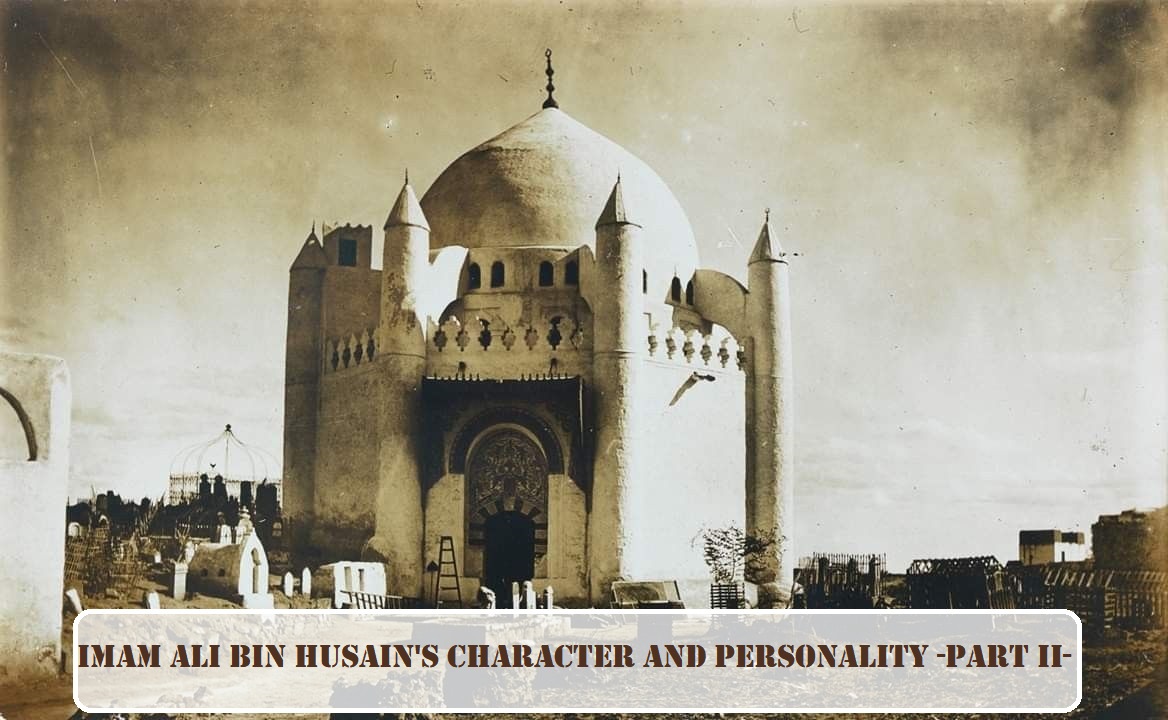* A man by the name of Zurara Bin Ayan once heard at midnight a caller saying, “Where are those people who give away this world for the next world?” another call came as a reply from the graveyard of Baqi saying, “Such a person is Ali Bin Husain (A.S).”
* If any member of his family asked him as to why he was praying like this even though he was sinless, he would reply, “Why shouldn’t I try to be nearer to Allah than I am now?”
* It is reported by Sheikh Mufid that once Imam Muhammed Baqir (A.S) saw that his father’s face had turned yellow through weeping all night. His forehead was hurt. His legs and feet were swollen from standing long hours in prayers. Imam Baqir started weeping. Imam Zainul Abidin (A.S) asked his weeping son to bring to him the book containing the prayers of Imam Ali (A.S).
He then read from the book for a while and closing it, he said,." who is strong enough to worship the way Ali Ibne Abi Talib used to do?" the massage from Imam Zainul Abidin was: compared to my grandfather my prayers are too short and too little. So let me do as much as I can.
Fatima Binti Ali, the Imam’s aunt called Jabir Bin Abdullah Ansari and requested to talk to the Imam and persuade him not to pray so much that his health could suffer. When Jabir talked to the Imam, the Imam reminded Jabir about the Prophet’s long prayers which led to the revelation of those Quranic verses in which Allah tells the Prophet to reduce his night prayers. The Prophet’s Allah. In the reason for such long prayers was to thank same way the Imam’s long prayer were only to thank Allah.
Whenever he heard of good news, he would bow down in “Sajda” to praise and thank Allah. Whenever his desires were fulfilled he would go in sajda. Whenever his problems were solved he would go in sajda. So much did he spend his time in sajda; praying or praising or thanking Allah that he became known as “Sayyidu Sajidin” or the leader of those who do “Sajda”.
Because he bent so much in prayers the skin over his knees and on his forehead was as hard as that of the camel. From time to this skin had to be peeled-off His forehead, too, was wounded because of remaining in the position of “Sajda” for long hours.
Both before prayers and during prayers the Imam’s behaviour would change in fear of Allah. For example, when he did his “Wudhu” his face would become pale and his body would shake. When he was asked for a reason he would reply , “Don’t you know before whom I am preparing to stand?”. Throughout his prayers his face continued to remain pale. After completing his prayers, in his “Duas” and “Sajdas” he would weep so much that his beard would be wet with tears.
Once someone saw him praying in the mountains on a bare rock which had become hot with the sun’s ray’s. The man asked for the reason. The Imnam explained saying, “This heat from the rock reminds me of the heat of the Hell and gives me a better understanding when I pray for forgiveness from Hell fire.”
It was because of his prayers that he became known as “Zainul Abidin” or the decoration of the pious people.
His piety was not just in prayers. He used to spend almost all his days fasting. A maid who spent several years serving Imam reports that throughout her service she never cooked any food for him nor prepared his bedding at night.
By some accounts, he fasted every day except on forbidden days such as on Idd days.
When he went for ‘Hajj’ he would do so most of the time walking. When he did use a beast of burden, he would never beat to make it move faster It therefore took him twenty days to travel between Medina and Mecca.
Once he was on such a pilgrimage to Mecca. He put on his “Ihram” and was about to say “Labaik Allahumma Labaik” which is required from every person doing “Hajj”, his face turned yellow and he could not say “Labaik” loudly. When he was asked why he did not do so, he replied, “Suppose I said Labaik and Allah replied LaLabaik (I don’t accept your Labaik) what would happen to me?” It is reported that his whole Hajj was spent in fear of Allah.
Source:
A Brief Biography of Ali Ibn Husain (a.s)
By: Muhammad Reza Dungersi. PH.D
[Vol. 1, Pg. 20-22].

